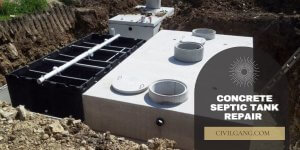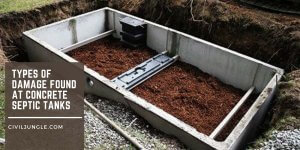
Table of Contents
Introduction Concrete Septic Tank Repair
Concrete septic tanks can last for decades without the need for homeowner intervention. Under normal conditions, concrete septic tanks are nearly resilient to harm, although they can be damaged by earthquakes, unknown construction problems, or heavy machinery being driven over them.
These things can often cause breaches in the concrete, allowing water to pour into the tank and raw sewage to escape. Because spilling sewage poses a health risk, it’s critical to understand how to tell whether your septic tank is cracked. If a crack is discovered, it should be fixed right away.
If you smell sewer gas outside your home or notice damp areas where they shouldn’t be, it’s a sign that sewage is escaping from the tank into the ground and that the tank is fractured.
Confirming Your Septic Tank Is Cracked
Cleaning and inspection by a registered septic technician is the only method to know for sure if a septic tank is fractured. If a crack is discovered, it will have to be repaired. Alternatively, if an overly old tank has caused substantial damage, it should be replaced.
Cracked Septic Tank Lids
The lid of a septic tank is one of the most common places for cracks. This is because the weight of the soil heaped on top of the lid puts it under constant strain.
Lid cracks, thankfully, are simple to repair. Simply remove the lid, clean it, and dry it before applying a concrete filler or adhesive to the cracked region. The lid will be as good as new once the adhesive or filler has dried and set.
Anyone walking on the surface above a septic tank lid with a structural flaw is at risk. It’s possible to tumble into the tank if the lid gives way. Because septic gases are poisonous, they can cause significant harm or even death.
Cracks in the Septic Tank Itself
The concrete tank itself can crack in addition to the lid cracking. Small hairline cracks that do not leak sewage or take in water can be ignored, but bigger fractures must be corrected.
Your septic repair professional will pump out and clean the tank to mend big cracks. They’ll let it cure completely before filling the cracks with concrete crack filler. Finally, the tank can be safely used once it has been healed.
Types of Damage Found at Concrete Septic Tanks

1. Septic Tank Leaks and Floods:
One of the most prevalent issues with concrete (and certain other) septic tanks is tank flooding, which can occur as a result of a drain field backup or surface runoff or groundwater into the septic tank.
Poorly sealed pipe connections, leaky septic tank risers, and leaky septic tank coverings can also cause water to flow into septic tanks.
2. Cracks in Concrete Septic Tanks
Concrete septic tanks can crack or parts can split, causing leaks as a result of not only incorrect effluent disposal (wrong site), but also undermining an effort at a septic loading and dye test because the tank liquid levels decrease unnaturally while the system is not in use.
Spalling can also occur in poorly mixed concrete. We’ve seen tanks made of poor-quality concrete (inadequate portland cement) that have corroded badly on occasion. Examining the tank inside may reveal effluent over the top of the baffles if the tank outlet or absorption system has been blocked, suggesting a system failure.
3. Sewage Tank Baffles That Have Been Damaged or Lost:
While concrete that has been correctly mixed and set is quite robust, we have seen cracked, broken, crumbled, or even completely lost baffles in certain concrete septic tank installations.
The septic tank distributes particles to the drainfield or soakbed without sufficient inlet and exit baffles, thus reducing its life; baffle loss at the tank entrance can lead to a sewer line obstruction and sewage overflow in the home.
4. Septic Tank Settlement:
After a system installation, settling of the ground will occur, especially during the first few months. It will also occur after a heavy rainfall or during the spring thaw. When your tank was set, loose dirt was filled in around it, so it’s natural that over the years the dirt compacts itself and sinks a bit
5. Lost, Missing, Insecure Septic Tank Access Covers:
Septic tank access covers that are lost, missing, or insecure allow someone to fall into the tank, which is usually fatal.
6. Septic Tank Damage Visible During or After Pumping:
Keep individuals away from a septic tank that is in an unknown state or does not have a safe, secure cover. One specific sign of a damaged or dead drain field is only noticeable when you try to service the tank. If you assume the tank just needs pumping, the service technician may spot water and sewage entering the tank from the outlet in a reverse flow.
Repairs to Concrete Septic Tanks
Even slight cracks in a septic tank can jeopardize the entire system. These little breaches may exacerbate with time, allowing sewage to leak out of the tank and into your physical environment. This is not only unclean, but it also puts everyone on the premises at danger of illness.
Allow water from the ground to soak into the tank. High liquid levels inside a septic tank can overwhelm the entire system, resulting in gurgling, foul aromas, damp spots in the yard, and slow drains and flushes, among other sewage problems.
Contaminate the surface and surrounding groundwater sources with bacteria, toxic sewer fumes, viruses, and other pollutants.
The dangers of a defective septic tank are not limited to your property’s bounds; they can also put a large number of people in danger.
1. Repairing Damaged or Lost Concrete Septic Tank Baffles.
We periodically discover that the baffles at a septic tank’s inlet or outlet ends have deteriorated, mainly due to a poor original concrete mix, but occasionally due to mechanical damage.
A septic tank with a missing or damaged baffle invites sewage backup into the building or solids into the drain field, thereby lowering the tank’s life.
2. Repairing Leaks into a Concrete Septic Tank.
We uncover leaks into the tank due to incorrectly aligned or placed entrance or exit pipe or missing, damaged gaskets at those points, in addition to leakage due to a fracture in a concrete septic tank.
If your septic tank is inundated by local groundwater or surface runoff, in addition to closing openings at tank piping and cracks or holes, the flooded tank will also flood the drain field or produce a sewage back-up into the building.
Some commenters suggested closing the septic tank covers and access ports, however these must be removed for servicing or repair, and you may be treating the symptom rather than the cause.
When faced with the significant cost of site drainage adjustments, we agree that sealing the septic tank lid may be a viable option. Make sure the flooded septic tank is caused by surface runoff or groundwater, rather than a backup or broken drain field, or you’ll be repairing the wrong issue.
Surface runoff should be directed away from the septic tank, and if necessary, an intercept drain should be installed to keep ground water and surface water away from the tank.
3. Repairing Cracks & Holes in a Concrete Septic Tank.
Concrete patching compounds, foundation repair compounds, epoxies, and crack sealers can be used to fix a crack or hole in a concrete septic tank. The following are important considerations:
Septic systems were primarily built to function with concrete tanks before the use of fibre plastic tanks. Prior to the early 1980s, the majority of septic tank systems were made of concrete.
Small cracks can appear anywhere in the cement tank system as it ages. In most cases, these little fissures are harmless and do not constitute a serious threat — unless they grow large enough to allow raw sewage to flow out of the tank.
For correct diagnosis, the severity and location of septic tank cracks will be considered during a professional inspection. The majority of tanks that are tested pass the examination, however in extreme cases, the tank may need to be replaced.
Concrete septic tanks will, with time, develop cracks and leaking, as is to be expected. If not properly monitored and maintained, concrete tanks can constitute a health and environmental concern.
Surfaces to be fixed must be free of sewage, dirt, and debris, as well as dry for some patch products.
How to Convert a Concrete Septic Tank for Other Uses?

In regions where there is no urban sewage infrastructure, a septic tank is being constructed. It’s utilised to store wastewater to prevent odours and disease from spreading.
The structure is straightforward. It’s a concrete underground room that’s split into two chambers. The larger portion takes up two-thirds of the overall volume, while the smaller portion takes up one-third.
Because sedimentation is heaviest at the septic tank’s entry, the majority of it is normally sloping (from the entrance to the pit). Filters are often sourced from the smaller component or from water flowing into the absorbent well.
The size of the septic tank can be calculated based on the amount of water used in the home. When building a house with up to five rooms, the rule is to create the pit with the least volume of three cubic metres, and each successive room increases the volume of the pit by one cubic metre.
In several nations, a legal minimum of 10 cubic metres is required. The actual construction begins with a hole eighty inches larger than the proposed septic tank and the pouring of so-called lean concrete into the future septic tank’s bottom.
It’s not a terrible idea to leave a single branch pipe in front of the septic tank so that it may be cleaned in the event of a backup. It’s worth noting that if you use a septic tank cleanser and maintenance agent, you’ll have to empty your tank less frequently.
Bio-enzymes are enzymes that break down organic waste into CO2 and water.
It’s as simple as dropping a sachet into a toilet bowl every now and then. In addition to requiring less emptying, the sewage odours are noticeably decreased. This is crucial if you want to use a concrete septic tank for something else because it will make your job easier.
The first step in making such a selection is to determine the type of property you’re dealing with. For example, a home’s tank is buried beneath a lawn that ends at a steep slope facing a lake. This means that coming from the lake, accessing the tank’s space would be simple.
The next stage in determining whether or not it is viable to convert a tank is to determine if it is possible to clean, paint, and otherwise modify the tank while avoiding any health hazards.
While a guest room would be unlikely to be installed in such a place, a storage facility is a far more feasible scenario—especially since few prospective robbers would consider to investigate in an area where a septic tank is thought to be stored.
When converting a tank, every step must be done according to code and permit requirements. One of the most essential rules of thumb is to never enter a septic tank, no matter how old it is, because there may be vapours present that may swiftly deteriorate your health and even put you at danger of death.
Can You Fix a Concrete Septic Tank?
The most common problem with concrete septic tanks is that they crack, which causes leaks and problems with soil contamination. If the leaks are only minor, usually they can be repaired and sealed; allowing you to get more life out of your tank.
Why Do Concrete Septic Tanks Fail?
In the case of a concrete septic tank, it can deteriorate and fail from the damage caused by the hydrogen sulfide gas and subsequent chemical rections that are a byproduct of anaerobic bacterial respiration. … Septic systems operate in an anaerobic environment.
Can You Repair a Leaking Septic Tank?
Sealing a leaking tank may fix the problem for a short time, but is not a long-term solution. Once a tank begins to leak, a replacement is usually recommended. Depending on the age of the system and local regulations, replacing a septic tank may require replacing the entire system.
Can You Repair the Top of a Septic Tank?
If it is not rusted, you can replace the rusted top with a heavy-duty plastic or concrete lid. Find the correct size by measuring the diameter of the opening. Concrete septic tank covers are heavy but strong and durable. Plastic covers offer faster access to the septic tank and are much easier to install.
How Does an Old Concrete Septic Tank Work?
Bacteria living in the septic tank break down some of the organic solids into liquid components, helping to reduce the build-up of sludge in the tank. The scum helps prevent odours from escaping and stops air entering. The treated effluent flows out of the tank through an outlet pipe as new waste-water enters.
What Are the Signs That Your Septic System Is Failing?
The first signs of a failing septic system may include slow draining toilets and sinks, gurgling noises within the plumbing, sewage odors inside, continuing drainage backups, or bacteria in the well water.
Why Is My Septic Tank Full Again?
There may be several reasons why you have an overfilled septic tank. An overfilled septic tank is often a signal that your drain field is malfunctioning. The water flow backs up when your drain field floods, causing the water level in your septic tank to rise. Other common issues are plumbing and excess water use.
What Is the Most Common Cause of Septic System Failure?
Most septic systems fail because of inappropriate design or poor maintenance. Some soil-based systems (those with a drain field) are installed at sites with inadequate or inappropriate soils, excessive slopes, or high ground water tables.
Old Concrete Septic Tank
Concrete septic tanks at an existing septic installation are usually viable, but might have damaged baffles or cracks that permit seepage of groundwater in or septic effluent out around the tank.
Bacteria living in the septic tank break down some of the organic solids into liquid components, helping to reduce the build-up of sludge in the tank. The scum helps prevent odours escaping and stops air entering. The treated effluent flows out of the tank through an outlet pipe as new waste-water enters.
What Is a Concrete Septic Tank?
Concrete septic tanks are currently the most popular type of septic tank on the market. The concrete septic tank’s popularity is due to its strength, weight, and durability. More specifically as to durability, if constructed properly, concrete septic tanks have a lower likelihood of breaking, cracking, or floating.
Old Concrete Septic Tank Lids
While this is an adequate installation, many septic professionals recommend replacing the concrete lids with plastic risers and lids for better access when inspecting and cleaning the tank. The plastic lids are also bolted down, providing an extra level of safety for the homeowner and family.
Concrete Septic Tank Leak Repair
To repair large cracks, your septic repair technician will pump out and clean the tank. They will let it thoroughly dry and then apply concrete crack filler to the cracks. Finally, once cured, then the tank can safely be used again.
Round Concrete Septic Tank
Septic tanks are typically rectangular in shape and measure approximately 5 feet by 8 feet. In most cases, septic tank components including the lid, are buried between 4 inches and 4 feet underground.
Concrete Septic Tank Repair
The most common problem with concrete septic tanks is that they crack, which causes leaks and problems with soil contamination. If the leaks are only minor, usually they can be repaired and sealed; allowing you to get more life out of your tank.
Septic Tank Crack Repair Cost
The national average for septic tank repair costs between $750 and $3,000, with the average homeowner paying $2,000 to replace a broken lateral line. Repair prices vary based on the problem and amount of work required.
Septic Tank Crack Repair
Cracks in septic tanks don’t always need to be repaired. If they are tiny and nothing leaks in or out, they might be left alone. On the other hand, large cracks or heaved concrete may be so severe that the tank needs to be replaced. Cracks in the tank are filled with cement or crack filler and allowed to cure.
| Cost to Repair Cracked Septic Tank | |
| Low-End | $150 |
| Average Range | $750-$3,000 |
| National Average Cost | $2,000 |
| High-End | $20,000 |
Like this post? Share it with your friends!
Suggested Read –
- Drip Distribution Septic System | What Is Drip Distribution Septic System | Advantages & Disadvantages Drip Distribution Septic System
- What Is a Community Septic System | Community Septic System Cost | Advantages & Disadvantages of Community Septic System
- What Is Chamber Septic System | How Much Does a Chamber Septic System Cost | Chamber Septic System Maintenance
- Alternative Septic Systems | What Are Alternative Septic Systems | Types of Alternative Septic Systems
- Skillion Roof House | Types of Skillion Roof | How to Build Skillion Roof | Advantages & Disadvantages
My septic tank has been smelling recently so I know that something is wrong and I want to fix it as soon as possible! Its interesting when you said that an overflowing septic tank can indicate a problem with your drain field. Thanks for the information on septic tank repairs and I hope that I can get a good service for my house soon.